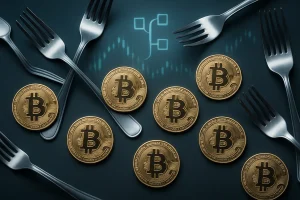HODL, FUD, & FOMO: A Beginner’s Guide to Crypto Slang 🧠

Get Breaking News First!
Editor’s choice
Ever feel lost when traders yell “HODL!” or talk about coins “going to the moon”? You’re not alone.
Crypto slang can feel like a secret code — but cracking it helps you protect your stack and trade with confidence.
Here are the must-know slang terms for 2025 so you can keep up — and keep winning.
Join our community of 400K+ and never miss breaking news!
We respect and protect your privacy. By subscribing your info will be subject to our privacy policy . Unsubscribe easily at any time
💎HODL

Born from a 2013 forum typo, HODL has become crypto’s battle cry.
It means holding through the chaos — no panic selling, no paper hands — because you believe in the bigger picture.
HODLers ride out crashes and ignore daily noise, trusting the long-term upside. For many, that conviction has been the difference between getting wrecked and coming out ahead.
🔥FOMO

Scrolling through crypto feeds during a bull run? That gut-punch feeling is FOMO — fear of missing out.
It pushes people into buying at the top, acting rash when everyone’s shouting green candles. Then the correction comes—and often, so do losses.
Remember 2017’s Bitcoin peak? FOMO made a lot of folks buy high, only to get crushed in the crash. Bitcoin’s journey through key market peaks and volatility shows it wasn’t just hype.
🧪 DYOR

“Do Your Own Research” is the ultimate shield in a sea of hype and scams.
It means digging into tokenomics, team, tech, and real use cases before you throw money at a project.
DYOR is what separates savvy investors from gamblers — and keeps you from getting caught in rug pulls and crypto scams.
😱 FUD
FUD — fear, uncertainty, and doubt — is often spread deliberately to shake markets.
Negative rumors or exaggerated news can spook investors, drive panic selling, and let insiders scoop up tokens at a discount.
When you see scary headlines or suspicious tweets, pause and verify through multiple sources before reacting. (Read our breakdown on crypto liquidity traps to see how panic selling creates opportunities for smart money.)
🚀 To the Moon
“To the moon, baby!” captures the excitement when prices skyrocket, like Bitcoin soaring from $3,000 to nearly $69,000.
But every moon mission has re-entry. Parabolic runs often end with brutal corrections.
The phrase is equal parts celebration and caution: markets that moon can crash just as hard. Knowing that keeps you hyped — but hedged.
Join our community of 400K+ and never miss breaking news!
We respect and protect your privacy. By subscribing your info will be subject to our privacy policy . Unsubscribe easily at any time
💎 Diamond Hands
“Diamond hands” are traders who hold through brutal dips, confident the price will come back.
Their opposite? Paper hands — selling early to cut losses.
Both reflect risk appetite: holding can mean bigger rewards but gut-wrenching swings, while selling early reduces risk but risks missing rebounds.
Knowing your temperament is key. Build a plan that fits your stomach for volatility — our guide to bag-holder psychology can help.
🐋 Whale

Whales hold massive amounts of crypto — enough to move markets with a single trade.
When they buy or sell, prices can spike or tank in minutes. Smart traders keep an eye on whale wallets to spot where big money is moving — and position early.
Want to learn how? Check out our guide on how smart money moves in crypto.
⛽ Gas Fees

Gas fees are the transaction tolls you pay to use blockchains like Ethereum.
They spike when the network is congested, sometimes costing more than the trade or NFT you’re trying to make.
Smart traders time transactions during low-traffic hours to save on costs.
🪤 Rug Pull

A rug pull is when developers vanish with investor funds, leaving holders with worthless tokens.
It’s one of crypto’s most brutal scams — just ask anyone who got caught in SaveTheKids or other influencer-backed disasters.
Protect yourself: research the team, read audits, and stay skeptical of anything promising guaranteed gains.
Want to dig deeper? Read our guide on crypto job scams and how to stay safe — same principles apply to spotting project fraud.
🔄 Flippening
The flippening is the hypothetical moment when Ethereum’s market cap overtakes Bitcoin’s.
ETH’s dominance in smart contracts, DeFi, and NFTs makes this a constant debate — and a favorite narrative during bull runs.
Whether it happens or not, tracking the ETH/BTC ratio can give traders clues about capital rotation and market sentiment.
🚫 Nocoiner
A nocoiner is someone who rejects crypto’s value — they either never buy in or dismiss it as a passing fad.
Some stay skeptical forever, but many flip once they see the tech, the gains, or the community momentum.
🌊 Altcoin Season

Altcoin season is when alts outperform Bitcoin, usually after BTC stabilizes.
This is when ETH, SOL, and new tokens rip higher, often delivering outsized gains compared to BTC.
Smart traders watch Bitcoin dominance charts and market trends to catch the rotation early. (See our guide on how to find 100x altcoins in 2025 to position before the pump.)
🎒 Bagholder
A bagholder is someone stuck holding heavily depreciated assets, refusing to sell even after brutal drawdowns.
It’s a cautionary tale: without an exit plan, you risk becoming exit liquidity for smarter players.
Learn how to avoid this fate in our guide on bag-holder psychology and why traders hold losing positions.
💥 Rekt
To get “rekt” is to suffer massive losses, usually due to risky trades or market crashes. Crypto’s volatility means many have faced this harsh reality.
Learn risk management and avoid over-leveraging to prevent becoming a victim of getting rekt.
📈 Pump and Dump
A pump and dump is when a group hypes a token’s price, pumps it sky-high — then dumps their bags on unsuspecting buyers.
This leaves latecomers holding worthless tokens and big losses.
Avoid getting caught: DYOR, check liquidity, and stay skeptical of “guaranteed moonshots.”
📊 ATH
ATH = All-Time High — the highest price a crypto has ever hit.
It’s a key indicator for traders gauging momentum and potential risk.
📢 Shill
To shill is to aggressively promote a crypto project — sometimes genuinely, but often to pump demand and offload bags.
Being able to spot shills helps you avoid hype traps and stay focused on projects with real fundamentals.
📌Final Thoughts
Mastering crypto slang doesn’t just make you sound like a degen — it helps you trade smarter, dodge scams, and stay ahead of the herd.
Think of this vocab as your survival kit for the wild world of crypto.
📬 Subscribe to our weekly newsletter for deep dives on market trends and pro strategies.
💬 Join 24K+ traders on Telegram for real-time alerts, alpha drops, and on-chain chatter.
Stay sharp — in crypto, knowledge is your edge.

















